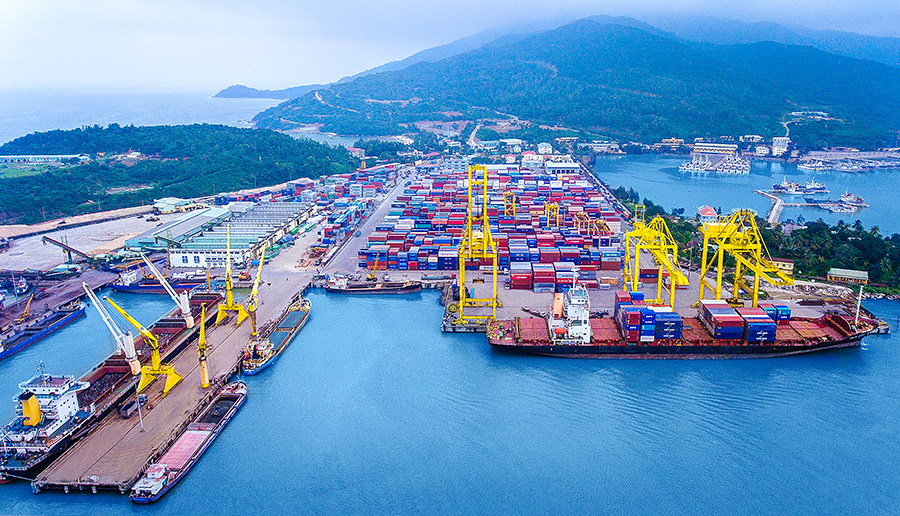Breakthrough development of marine economic industries
The Vietnamese government has issued a special resolution on the National Master Plan for the 2021 - 2030 period, with a vision towards 2050, which defines the breakthrough development of marine economic sectors, especially tourism and marine services; maritime economy through four marine economic zones.
 |
| Promoting the logistics industry with a system of seaports like the Tien Sa Port. |
The resolution clearly states the ultimate target of building Viet Nam into a strong and rich country based on the sea with sustainable development, prosperity, security and safety.
The country will set an important sight on developing more breakthroughs in marine economic sectors, especially tourism and marine services; maritime economy; exploiting oil and gas and other marine mineral resources; aquaculture and fishing; coastal industry; renewable energy and new marine economic sectors.
In particular, the national master plan is oriented towards marine and coastal areas. In the northern marine and coastal areas (Quang Ninh to Ninh Binh), focus is on building the Hai Phong - Quang Ninh area into a marine economic centre, a driving force for the development of the key northern economic region; developing Quang Ninh into a national tourism centre connecting with major international tourist centres of the region and the world at large as well as promoting a number of marine industries with advantages associated with coastal economic zones and industrial parks.
The North Central Coast and Central Coast region (Thanh Hoa - Binh Thuan) emphasises on strongly developing the marine economy in combination with ensuring national defense and security at sea, especially offshore fishing and aquaculture.
Other tasks include restructuring fishing, aquaculture and seafood in association with processing industry, logistics services and fisheries infrastructure, ensuring sustainability and high efficiency; improving the efficiency of development of coastal economic zones, developing a system of coastal urban areas, marine tourism and eco-tourism centres of regional and international stature, developing seaport services, especially specialised seaports associated with economic zones and industrial parks.
With regard to the South-eastern marine and coastal areas (Ba Ria - Vung Tau - Ho Chi Minh City), heed will be paid to developing the Cai Mep - Thi Vai Port into an international transshipment port, associated with the Trans-Asian economic corridor.
Importance will be attached to developing seaport logistics services, maritime safety assurance services, oil and gas extraction and processing industries, supporting industries and petroleum industry services and high-quality beach resorts.
As for the Southwestern marine and coastal areas (Tien Giang - Ca Mau - Kien Giang), the most important task will be on developing Phu Quoc into a strong marine eco-tourism and service centre of international stature.
Measures will be taken to develop gas industry, gas processing, gas power, renewable energy, aquaculture, seafood exploitation, logistics services and fishery infrastructure, promote economic development in islands in combination with ensuring national defense and security at sea.
In particular, as for Da Nang, Director of the Institute for Socio-Economic Development Research Huynh Huy Hoa said that the advantage of the North Central and Central Coast regions is the marine economy.
Accordingly, in order for Da Nang to promote its potential and strengths to become a regional and international marine economic centre, it is necessary to soon complete a coastal tourist route and highways and other related type of infrastructure to boost regional linkages, thereby appealing for more investment flows for the modernisation of Chan May and Lien Chieu seaports.
In fact, investment in transport infrastructure is intra-regional but it also help Da Nang connect with neighbouring economic regions so as to limit the topography-triggered separation.
In particular, Da Nang can grasp potential opportunities to develop its marine economy thanks to the project “Development of marine economic clusters in association with the building of strong marine economic centres in the period by 2030”. According to the project, Da Nang is located in the marine economic center and plays a leading role in performing the task of developing economic clusters, inter-sectoral and inter-provincial linkages to exploit and use marine resources with high efficiency.
At the same time, Da Nang will boost its active engagement in developing the clusters of marine economic sectors associated with the growth of an associated business community, thereby creating an ideal environment for the development of lucrative and highly-attractive marine economic sectors.
Reporting by TRIEU TUNG - Translating by A.THU